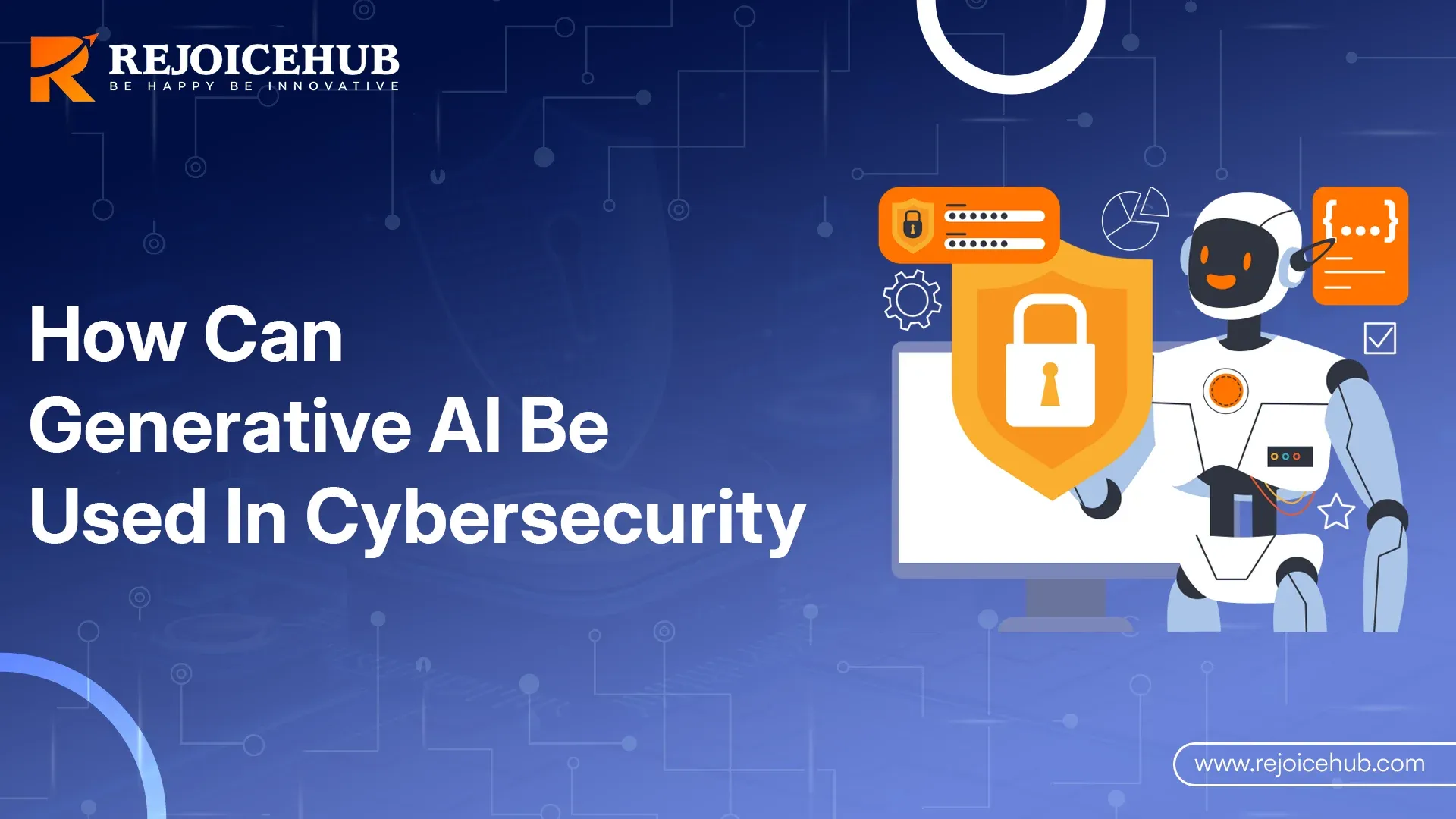
Today's tech and startup world may look simple from the outside, but managing tech platforms poses a big challenge for the founders and their team on a daily basis because when you have audience and user data, many scammers, hackers groups try to cyber threat you and harm company data by using phishing emails, sneaky malware, even they perform DoS attacks so that they find a loophole from anywhere to access company's data systems. And keeping the company's systems secure and working is a very stressful task for the founders and their security team. In most malware attacks, it has been seen that the mistakes of the human employees remain at the forefront due to which the hackers are able to find the loopholes, whether you study the Equifax Data Breach (2017) or the Boeing Ransomware Attack (2018), it is common in all these attacks that the attack was successful because the security standards are not followed by the employees.
To solve all these problems, many companies have started using generative AI for small and repetitive tasks, as it can perform tasks ranging from email writing to image post generation quite well. And when generative AI is used, the issue of cyber threats also remains less, because AI models are designed to work on a fixed and accurate path, due to which the chance of making mistakes like humans is very less, but as we know that no technology is ever foolproof.
But still generative AI is making a lot of impact in the cybersecurity sector and in today's detailed article we will know about how generative AI is being used for cybersecurity, what are its real world examples and what can be its benefits and risks so that you get a detailed information about what are the capabilities of generative AI. This is why it is attracting the cybersecurity world.
Quick Summary
Generative AI is like a magical content-creating or pattern learning machine, as it can perform such creative tasks in minutes that would take a professional artist many days to complete. And generative AI has become so advanced that it can provide results in all formats, whether you want the results in text, images or even code format. And it will prove to be a game changer in cybersecurity as it can fast spot threats, and it can even predict the chances of an attack on a company’s system before the attack happens.
This gives employees a better understanding and time to strengthen their systems and the biggest advantage is that in traditional cyber attacks, when there was a data breach, the company had to shut down its server for some time but due to Generative AI it has become easier to strengthen cybersecurity while performing the company's operations.
But it is not as cool as it sounds, because hackers also use these same models to access systems in which they take the help of phishing emails, deepfakes, and malware, and if there are even small loopholes in the company then they can use that to access a lot of user data, and the advantage of technology advancement proves to be even better for the hackers in some scenarios.
What is Generative AI in Cybersecurity?
To understand generative AI better, it is important to first understand artificial intelligence because generative AI is a subset of it, it uses new creative algorithms and for this it uses large language models (LLMs), generative adversarial networks (GANs), and variational autoencoders (VAEs) models, so that it can create new and unique content from scratch, and it can also give you results in all formats, whether you want it in text, images or codes.
All these capabilities of Generative AI are effectively used for Cybersecurity, wherein advanced AI models are used for the generation of new data, codes and patterns and unusual activity detection to further strengthen cybersecurity and identify threats and try to resolve them before they occur.
Use of Generative AI in Cybersecurity
Generative AI is used a lot in Cybersecurity, whether it is to increase the security of the company or to strengthen weak codes or to provide information about cyber threats to the company in advance, mainly generative AI is used for this to improve cybersecurity further, so let's understand in detail how generative AI is ultimately used in the cybersecurity world.
-
Threat Detection and Response: Generative AI can find anomalies even from large data which is not at all easy for humans, because if suppose there is a login attempt of any system of the company at 3 am, in such a case generative AI plays a very important role because, even in the unavailability of human staff, generative AI handles such situations very well and tries to fix it. Overall, it can handle small as well as big cyber attacks. And the biggest pro side of generative AI is that it gives the exact information about the problem to the security team, and in the traditional system, the security team used to find and fix the issues manually.
-
Phishing Detection: Such unwanted emails which pretend to be bank emails or some important email from outside, but in reality, there is secret or hidden malware available in them, such phishing emails can be easily found by AI-powered Generative AI. And for this, Generative AI analyzes email content, sender info, PDF, links, embedded images, which gives a basic idea of whether a mail is a phishing mail or not. Popular mail services like Gmail and Outlook also use this system to detect Spam or phishing emails, and because of this, millions of phishing attempts are prevented daily.
-
Security Policy Documentation: It has been seen that generative AI does a lot of good work in writing security policies. And generative AI can do everything from security documentation to writing guidelines automatically, and its writing is also very clear and detailed. Important tasks like guidelines, documentation can be handled by generative AI very smartly.
-
Defense Simulation: large companies release bug bounty programs to test their defense system in which they are given prizes for finding loopholes in the company’s security; it has now become possible to do the same thing with generative AI in which you can test the security of your company, that too without any real attacks. Generative AI uses fake malware or phishing emails to create an environment as if the company has been cyberattacked, so that it can analyze whether the company's current system is capable of handling cyber threats or not.
-
Attack Simulation (Red-Teaming): AI always tries to train itself according to the current system and hacking trends, in which it mimics hacker tactics on the company's system, so that it can find the weak spots of the company and fix them before the real attack happens. Since everything from assets to valuation of a tech startup depends on the data, even a small data breach can damage the company's reputation and trust; therefore, the core focus of tech companies remains on cybersecurity.
How Generative AI Affected Security?
Generative AI is having a significant positive or negative impact in the cybersecurity sector, and the way in which a generative AI can impact a company’s security system also depends to a great extent on the working of the company’s security team and the generative AI model. Let’s learn about generative AI and its impact on security.
Positive Impacts of Generative AI on Security
Though we know a lot about the positive impact of generative AI, let’s try to understand it a little more deeply that how smart companies use it, due to which their security system remains so unbreakable.
1. Threat Detection and Prevention: Generative AI models like GANs are used to detect potential cyber threats and defend against them. In this, AI generates synthetic attacks and uses the data to train its new models for better detection and solution of malware, phishing.
2. Security Automation: Generative AI is also able to positively promote cybersecurity because it automatically manages log analysis, vulnerability scanning, and incident response on a daily or fixed timing basis, making it possible to reduce human error and response time.
3. Behavioural Analysis: Generative AI analyzes user behaviour more, and if it detects even slight anomalies in their usage patterns and activity, it provides first-layer security very quickly by blocking such accounts and users from the server so that potential threats can be stopped. This gives AI an indication that the account may be compromised, and it can also suspend such accounts.
4. Realistic Simulations for Training: As we already know, AI doesn’t wait for real attacks to happen; rather, it creates realistic phishing emails, ransomware scenarios, or attack environments to strengthen its systems so that AI and employees can get trained to tackle such situations.
5. Enhanced Malware Detection: Generative models do not rely on traditional signature-based methods but can detect even zero-day threats by detecting anomaly patterns.
Negative Impacts of Generative AI on Security
Generative AI is quite advanced, but as we know, no technology or model can ever be fully proven, and if the training of Generative AI is not done properly or the security system team is not highly skilled, then the company may have to see negative impacts due to Generative AI.
1. Sophisticated Phishing and Social Engineering: Attackers can create convincing fake emails, voice clones, or deepfake videos using generative AI to trick users or systems.
2. Malware Creation: ChatGPT or open-source LLM models are misused a lot, in which AI is used from content generation to malware generation. Therefore, despite using advanced generative AI, hackers still find its loopholes through the LLM model, making malware, ransomware, or fake code through ChatGPT or LLMs has become quite popular for scammers.
3. Bypassing Security Systems: There are some generative AIs that can show legitimate traffic and can also evade firewalls by mimicking human behaviour, such as they can easily bypassing spam filters and anomaly detectors in the system, and such models are being used extensively to breach company data.
4. Data Poisoning Attacks: Hackers can try to craft poisoned data using AI, which can manipulate machine learning models and will not pose a threat, due to which the probability of activities like phishing increases significantly in such scenarios.
5. Deepfake and Impersonation Risks: The use of Deepfake audio and video is also increasing significantly for manipulation and fraudulent activities, and in cybersecurity, Deepfake media can be used to impersonate higher-level employees or executives of a company, increasing the chances of fraud, disinformation, and social engineering breaches.
Also Read: How Generative AI Can Help Your Business Operations
Benefits of Generative AI in Cybersecurity
Generative AI is making a huge impact in the Cybersecurity sector, from its automatic detection to tackle cyber threats. Generative AI also has many benefits in terms of cybersecurity. Let us know about those benefits in detail.
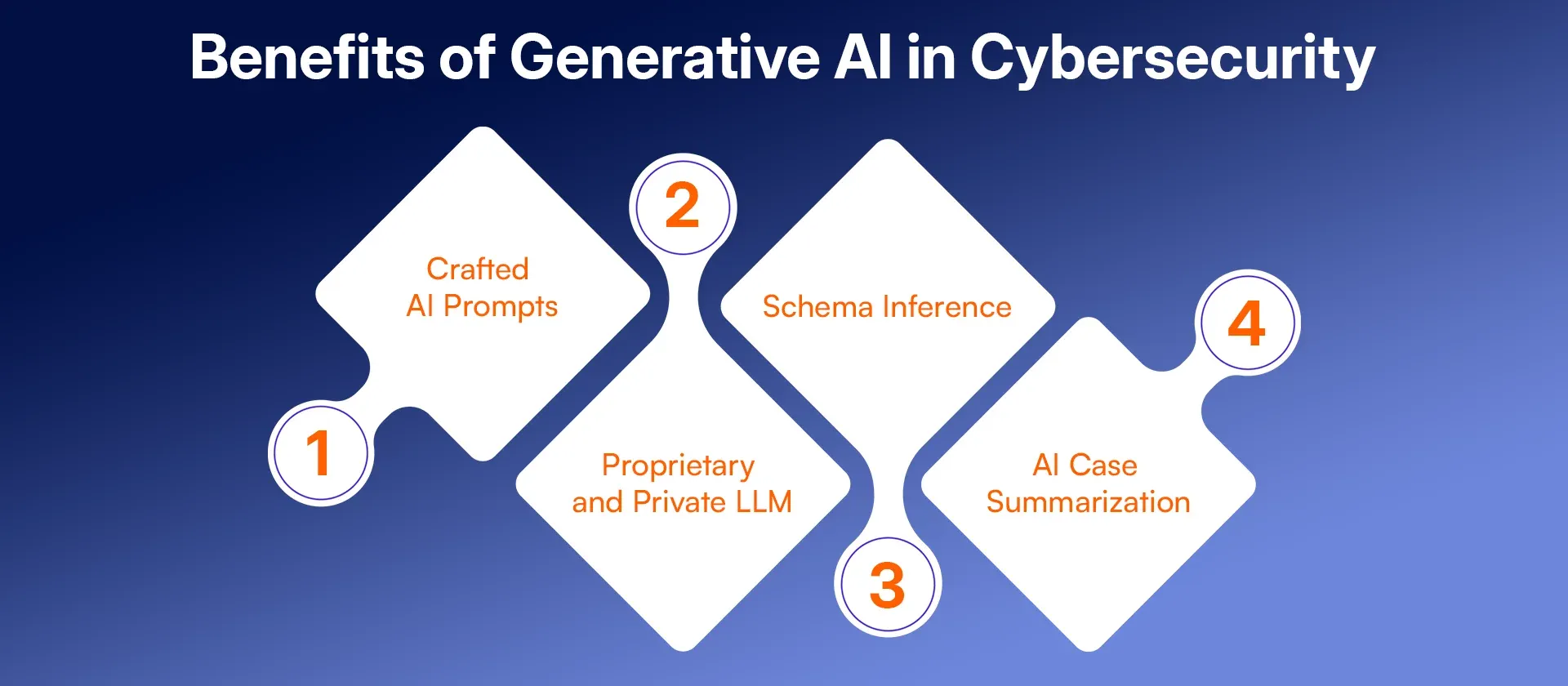
-
Proprietary and Private LLM: No company wants their sensitive security data should be available with a public AI model. Many companies like Swimlane’s Hero AI use a private large language model (LLM) so that the secrets and confidential data of the company can be kept secure, so that no one can access such data publicly.
-
Schema Inference: Mapping different systems is no less than a headache, and AI's schema inference tool figures out how to automatically connect the dots of any anomalies or patterns so that it becomes possible to build an efficient security system.
-
AI Case Summarization: Just think about it, if any incident occurs in your company's security system at 1 a.m. in the night, will it be possible for a human employee to deal with it? At such times, generative AI solves such issues to a great extent, in which if it detects any security threat or any anomalies, it creates a summary of such incident and gives a security alert to the rest of the company's systems, so that whenever the security team is available, they do not waste time in detecting the problem, but use the incident summary and fix it fastly.
Examples of Generative AI in Cybersecurity
Let us now try to understand Generative AI with real-world examples that how it is being used in Cybersecurity, so that you have the exact knowledge of how you can use it if you want to implement it in your businesses.
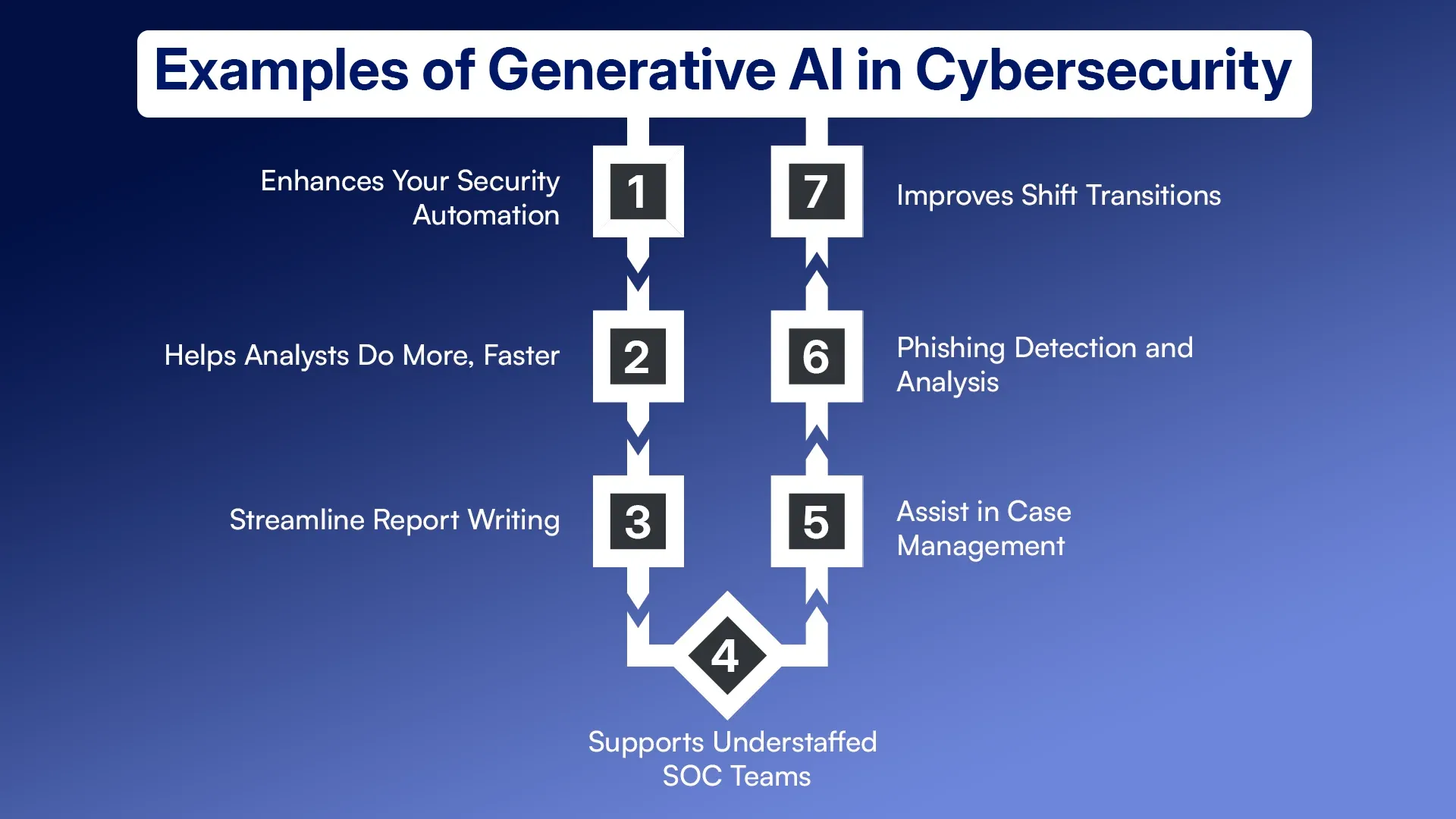
-
Enhances Your Security Automation: Generative AI adds another dimension to your system. It works like a smart firewall that not only protects your system from threats but also handles them smartly, similar to how a highly skilled security engineer does. Like a traditional security system, it analyzes your data instead of running scripts and suggests your next steps accordingly. AI reduces the manual workload and tries to make the workflow smoother.
-
Helps Analysts Do More, Faster: Security teams follow a lot of software security paths and processes when they have to detect manual anomalies in the system. But AI summarizes the incidents in the system and sends prioritised alerts to security analysts so that they can act fast and fix them.
-
Streamline Report Writing: Today, no expert engineer would like to do repetitive tasks like daily report writing, but models like Generative AI do this work in a much better way and automatically provide absolutely clear and compliant reports to the company's security team.
-
Supports Understaffed SOC Teams: Even if there is a shortage of cybersecurity employees in the company, Generative AI performs like a security employee. So that the core security team can work on important projects.
-
Assist in Case Management: The best quality of AI models is that they describe the historical attacks of the companies very well, the reason for it and also tell stepwise what the weak points in our system are, which can be used for a cyber attack on our system. This increases the security of the companies even before the attack and also reduces the chances of threats.
-
Phishing Detection and Analysis: Despite so many security advancements, even now, 4 out of 10 emails are related to spam or phishing attacks, so you can imagine how important phishing detection is and removing it from the system database. So, to tackle this problem, AI creates realistic phishing scenarios so that employees and their own database can be made capable of handling phishing attacks. If you have used Gmail, you must have noticed that Gmail marks spam or phishing mails in red beforehand and the user is already instructed not to tap any link or metadata of this mail as it could be a phishing attack or suspicious, And this is available in mailing services like Gmail only because of the advanced generative and security system.
-
Improves Shift Transitions: Changing shifts in the company's security system is a big headache for the employees, but generative AI reduces this headache to a great extent as it automatically prepares security status reports in detail so that when the next team comes to their shift, they are aware of the previous and current status, which helps in maintaining the workflow smoothly.
Alos Read: Building a Smarter Factory: Generative AI's Role in Modern Manufacturing
Advantages of Generative AI in Cybersecurity
Let's try to understand in detail why companies are preferring generative AI for their cybersecurity and how it is able to manage security so effectively.

-
Proactive Defence: Generative AI not only reacts but also gives security predictions. It analyzes the patterns of attacks well and tries to spot loopholes and anomalies. It helps you to fix the vulnerabilities of your system before hackers attack. And this AI also provides real-time alert management and incident summary, which helps in fixing the vulnerabilities as quickly as possible.
-
Enhanced ROI: No one wants to invest their maximum budget in security, which is why companies prefer Generative AI because it smartly allocates resources and also secures critical assets at a very genuine price, and its overall ROI is worth it for the companies.
-
Competitive Advantage: There are many advantages of adopting AI security early, and it gives you the competitive advantage of being the first mover in the market. And now, most users are very concerned about their data security, and when the company provides high-end security, then the users prefer it.
-
Improved Operational Efficiency: Automating repetitive tasks like documentation or threat filtering frees up your team from low-level tasks so they can focus on strategic work. And generative AI reduces manual labour costs and speeds up system processes.
Because of all these advantages, businesses are preferring generative AI as it gives them security and a competitive edge. And it also makes it easier to gain trust among users.
Generative AI Cybersecurity Risks
We have learned about the positive side of Generative AI for Cybersecurity. Now let us know about its negative side as well, so that you do not completely rely on Generative AI for your security system, so that your security system remains better in all aspects.
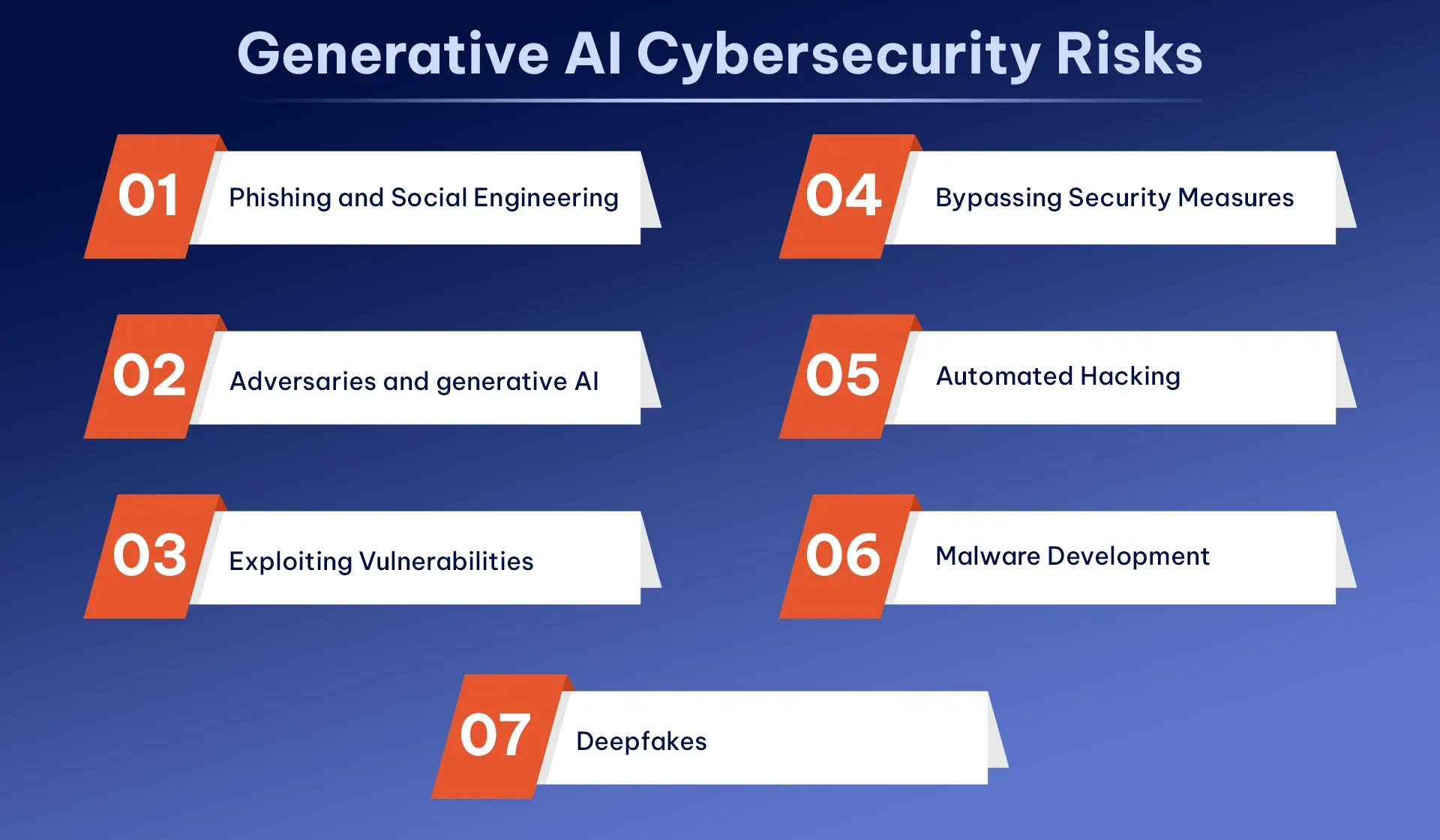
-
Phishing and Social Engineering: Some AI tools can easily craft convincing phishing emails, which sometimes even fool weakly trained Generative AI. That is why, for the final decision, companies rely more on their human security engineers than on any security AI or software.
-
Adversaries and Generative AI: Hackers are using AI to analyze systems for weak spots, which is why companies prefer private generative AI in their security systems, because anyone can find loopholes in the company's system from the publicly available data.
-
Exploiting Vulnerabilities: Many such attacking software are also available in the market, which use AI systems, due to which they can scan the code or networks at lightning speed, so that they can find out the vulnerabilities of the system. As AI advances, its unethical usage will also increase.
-
Bypassing Security Measures: It is quite easy to bypass CAPTCHA these days with the help of AI tools, as these AIs are able to mimic human behaviour very well. They can even bypass biometric systems and security protocols if there are even slight loopholes or bugs in the system.
-
Automated Hacking: Why hack manually when AI can do it for Hackers automatically? Currently, AI can automate large-scale attacks from different IP addresses or devices, making them harder to counter.
-
Malware Development: Nowadays, even self-evolving malware can be designed, which changes its code according to the security system and transfers confidential data of companies in an active way, and many times, the security system does not even get to know about it.
-
Deepfakes: AI-generated audio and video can impersonate CEOs or employees, hackers also try to make the secrets of the company public and such activities spoil the reputation of the company and customer trust.
What is the Future of Generative AI in Cybersecurity?
Generative AI is still in an evolving phase in the Cybersecurity sector as it has as many negative uses as positive ones, but as it evolves, its accuracy will also increase, so let’s get to know about its future trends.
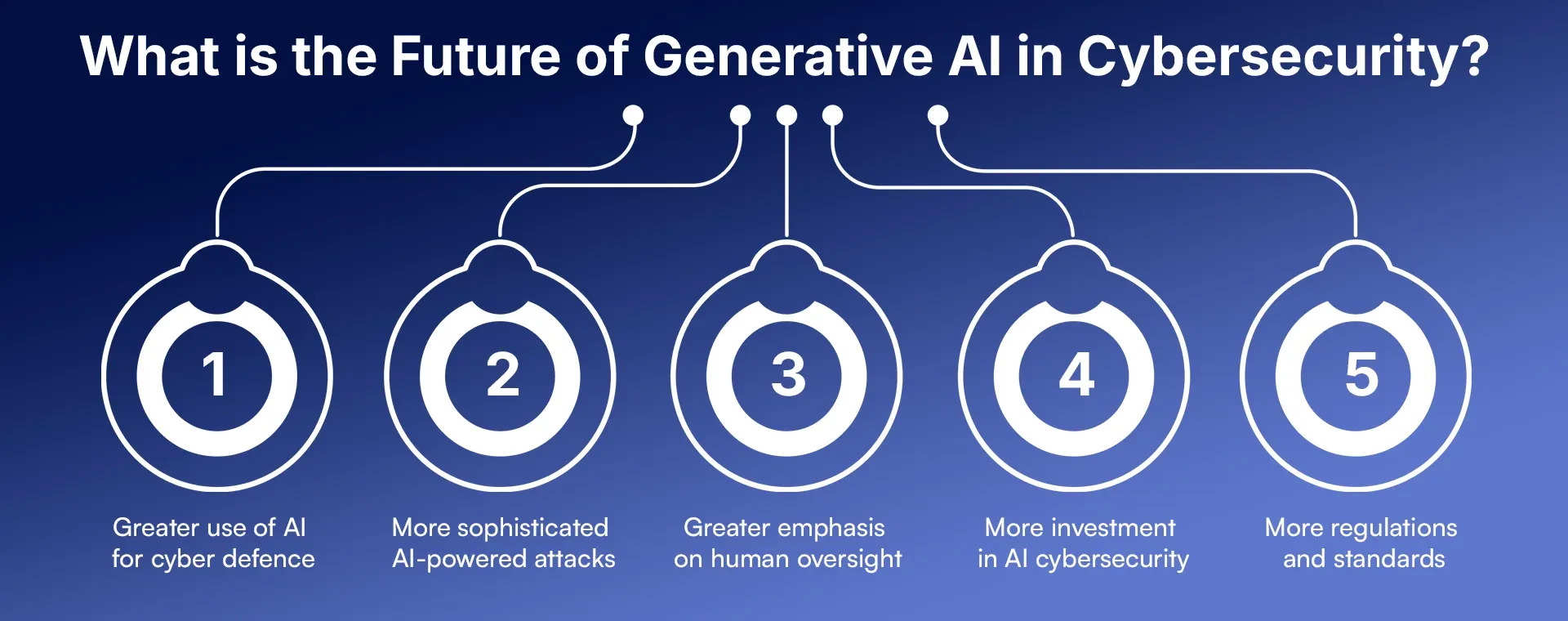
-
Greater Use of AI for Cyber Defence: Generative AI is a defensive model that does not wait for attacks but starts preparing for them beforehand and can perform tasks like threat detection, analysis, and response quite effectively, allowing security teams to remain proactive.
-
More Sophisticated AI-Powered Attacks: With the advent of generative AI, we cannot say that cyberattacks will completely stop because, as AI advances, its misuse will also increase.
-
Greater Emphasis on Human Oversight: AI tools are awesome, but you cannot call them completely perfect. Because it is better to rely on human staff for final security decisions, as AI can give erroneous reports.
-
More Investment in AI Cybersecurity: As cyber risks increase, companies will invest more in security, and a portion of it can be invested in technologies like generative AI.
-
More Regulations and Standards: As the use of AI for security increases, data privacy and security standards will be improved further, and country governments can also bring their own data laws so that no foreign company can misuse the data.
Conclusion
I hope you have detailed knowledge of why generative AI is being preferred so much in cybersecurity. Currently, modern security systems and generative AI are still evolving, but most companies are not looking at generative AI as an option in security but as a future scope. And the cost of generative AI is also currently quite affordable for most companies, hence everyone is using it as an extra layer of security so that in future it can be easily deployed along with the company's security system with complete action-taking capabilities. As we know, this AI is still in the evolving phase, and hence, Hackers and scammers are trying to use it a lot for security breaches. To tackle it, companies are designing new algorithms and sets of rules to detect generative AI manipulative patterns.
Apart from this, if you are a startup founder or you too want to integrate generative AI or security software in your businesses, you can get in touch with RejoiceHub’s dedicated team who will suggest you the best cybersecurity strategies for your business so that your focus remains on the scale of your business rather than always worrying about safety.
As cyber threats increase, generative AI will keep getting more advanced. We hope that in the future the security system can be made almost foolproof so that the core focus of companies remains on growth and better service.
Frequently Asked Questions
1. How is generative AI used in cybersecurity?
It’s used to detect threats, automate responses, write policies, and simulate attacks to test defences. But hackers also use it for phishing, malware, and deepfakes, so currently, most companies rely on human security teams for final actions or security.
2. What is generative AI, and an example?
Generative AI is a subset of Artificial Intelligence that is expert in new content or creative tasks, and its modification is being used in Cybersecurity and various sectors.
3. Can generative AI replace human cybersecurity experts?
Not completely, generative AI is currently the best option for repetitive tasks and efficiency boosts, but human expertise is still needed for context and complex decisions.
4. How is generative AI transforming cybersecurity strategies?
Generative AI is transforming cybersecurity strategies in many aspects, but generative AI has enabled security systems to move from reactive to proactive, including attack prediction, automating responses, and faster security implementation.
5. What are the risks of generative AI in cybersecurity?
Hackers can use sophisticated phishing, malware, and deepfakes to manipulate poorly trained people and cause AI to report false positives or even miss anomalies or threats.
